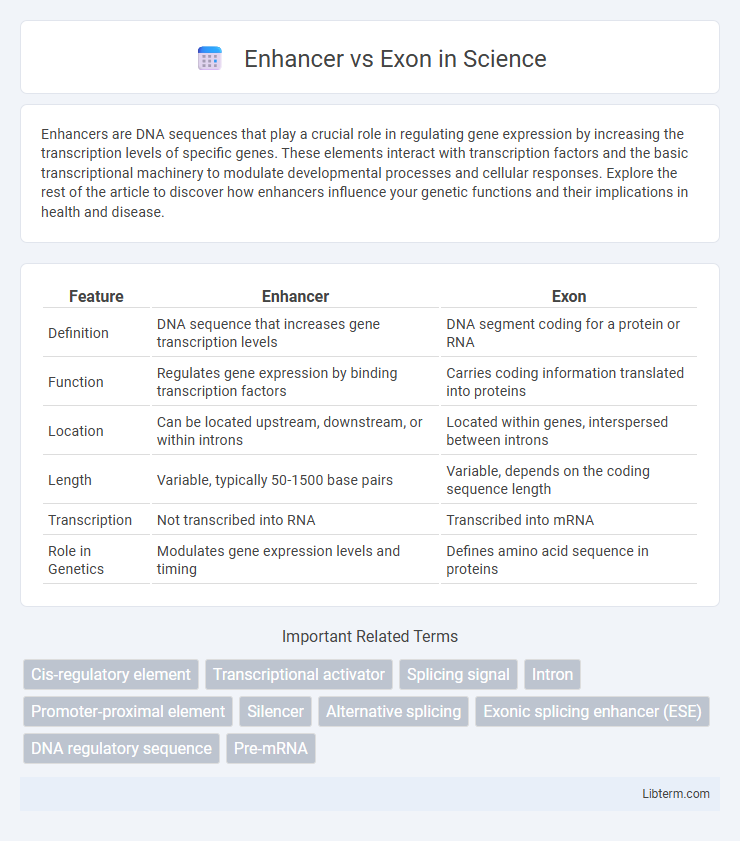Enhancers are DNA sequences that play a crucial role in regulating gene expression by increasing the transcription levels of specific genes. These elements interact with transcription factors and the basic transcriptional machinery to modulate developmental processes and cellular responses. Explore the rest of the article to discover how enhancers influence your genetic functions and their implications in health and disease.
Table of Comparison
| Feature | Enhancer | Exon |
|---|---|---|
| Definition | DNA sequence that increases gene transcription levels | DNA segment coding for a protein or RNA |
| Function | Regulates gene expression by binding transcription factors | Carries coding information translated into proteins |
| Location | Can be located upstream, downstream, or within introns | Located within genes, interspersed between introns |
| Length | Variable, typically 50-1500 base pairs | Variable, depends on the coding sequence length |
| Transcription | Not transcribed into RNA | Transcribed into mRNA |
| Role in Genetics | Modulates gene expression levels and timing | Defines amino acid sequence in proteins |
Introduction to Enhancers and Exons
Enhancers are regulatory DNA sequences that increase transcription levels of associated genes by facilitating the binding of transcription factors, often acting over long genomic distances. Exons are coding regions within a gene that are transcribed into mRNA and ultimately translated into proteins, playing a critical role in determining protein structure and function. Understanding the distinction between enhancers and exons is vital for studying gene expression regulation and the genetic basis of diseases.
Definition and Basic Functions
Enhancers are regulatory DNA sequences that increase the transcription of associated genes by binding transcription factors, often acting at a distance from the gene promoter. Exons are coding regions of a gene that are transcribed and spliced together to form mature messenger RNA, ultimately translating into proteins. While enhancers regulate gene expression levels, exons define the protein-coding sequence within the gene.
Genomic Locations: Enhancer vs Exon
Enhancers are regulatory DNA sequences located distal to genes, often found thousands of base pairs upstream or downstream from the transcription start site, including within introns or intergenic regions. Exons, in contrast, are coding regions of a gene arranged sequentially along the DNA strand and are generally situated within the gene body between introns, directly contributing to the final mRNA sequence. The distinct genomic localization of enhancers versus exons reflects their different functional roles, with enhancers modulating gene expression from variable positions and exons providing the template for protein synthesis.
Role in Gene Expression Regulation
Enhancers are regulatory DNA sequences that increase the transcription levels of target genes by facilitating the binding of transcription factors and the assembly of the transcriptional machinery, often working at a distance from the gene's promoter. Exons are coding regions within a gene that are transcribed into mRNA and translated into proteins, directly contributing to the gene's functional output. While enhancers modulate gene expression by controlling transcription initiation, exons determine the specific protein sequence produced through their inclusion in the mature mRNA.
Molecular Mechanisms of Enhancers
Enhancers are regulatory DNA sequences that increase the transcriptional activity of specific genes by facilitating the assembly of transcription factors and coactivators at promoters, often through DNA looping mechanisms that bring enhancers into close proximity with target exons. Unlike exons, which encode protein sequences within the gene, enhancers operate at the molecular level by recruiting mediator complexes and chromatin remodelers to modify histone marks such as H3K27ac, thereby enhancing RNA polymerase II recruitment and transcription initiation. These dynamic interactions enable enhancers to precisely control gene expression patterns essential for cellular differentiation and development.
The Coding Functions of Exons
Exons are essential coding sequences within genes that directly translate into proteins, determining the amino acid sequence and functional properties of enzymes and structural proteins. Enhancers are regulatory DNA elements that do not code for proteins but increase the transcriptional activity of specific genes, influencing gene expression levels. The coding functions of exons ensure the precise synthesis of proteins critical for cellular structure, signaling, and metabolism.
Interaction Between Enhancers and Exons
Enhancers and exons interact through complex regulatory mechanisms influencing gene expression and alternative splicing. Enhancers, distal DNA elements, modulate transcription by recruiting transcription factors that impact exon inclusion or exclusion during RNA processing. This interplay between enhancer activity and exon selection is critical for generating transcript diversity and regulating tissue-specific gene function.
Impact on Genetic Diseases
Enhancers regulate gene expression by increasing transcription rates, often affecting multiple genes across large genomic distances, which can lead to dysregulation and contribute to complex genetic diseases such as cancer and developmental disorders. Exons contain the coding sequences for proteins, and mutations within exons frequently result in altered or truncated proteins, directly causing monogenic disorders like cystic fibrosis or muscular dystrophy. Understanding the distinct roles of enhancers and exons reveals how regulatory mutations impact gene expression patterns while coding mutations alter protein structure, both critically influencing the onset and severity of genetic diseases.
Techniques to Identify Enhancers and Exons
Techniques to identify enhancers often involve chromatin accessibility assays such as ATAC-seq and DNase-seq, combined with histone modification profiling like H3K27ac ChIP-seq to locate regulatory regions that increase transcription. Exon identification primarily relies on RNA sequencing (RNA-seq) for transcriptome mapping, supported by computational tools like Cufflinks and StringTie that assemble and annotate exonic regions within gene transcripts. Integration of these methods enables precise differentiation between enhancers, which regulate gene expression from a distance, and exons, which constitute the coding segments of genes.
Future Research Directions
Future research in genomics aims to unravel the dynamic interplay between enhancers and exons, particularly how enhancer elements influence exon splicing and transcript diversity. Advanced techniques like CRISPR-based screens and single-cell RNA sequencing will enable precise mapping of enhancer-exon interactions in different cellular contexts. Integrating epigenomic data with 3D genome architecture models holds promise for identifying novel regulatory mechanisms that could be targeted in gene therapy and precision medicine.
Enhancer Infographic

 libterm.com
libterm.com